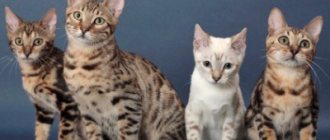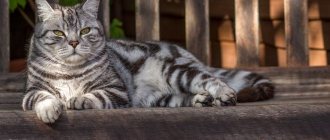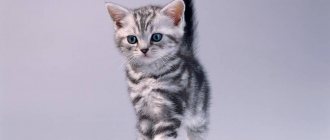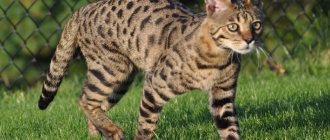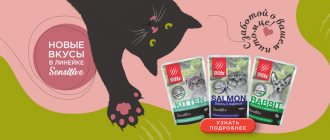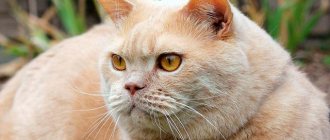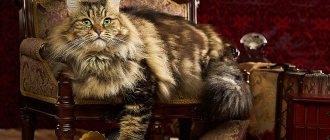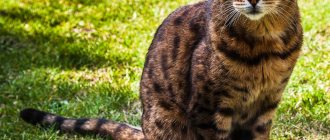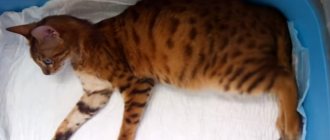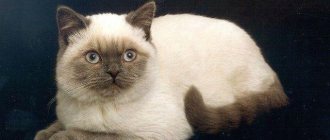Among the short-haired breeds, the snow Bengal cat is considered the most beautiful. The animal has a beautiful physique and a lively, independent character. The peculiarity of the representatives of the breed is their color. It has 3 varieties - sepia, linx and mink, which differ in the shade of the main background and pattern. The future owner of a snow bengal should take into account the subtleties of coloring in order to acquire a real purebred pet.
According to breeders, the Snow Bengal cat can be adopted by people who will devote a lot of time to it, since the animal is very talkative and sociable.
How the red hybrid began to develop snowy colors
The history of the Bengal breed, which does not go back to the very depths of centuries (it is just over half a century old), allows us to trace the emergence of an unusual, very elegant variety with snowy colors. Even a person far from the “cat” science of felinology understands that pale Siamese with dark limbs and heads participated in the selection. Experts know much more: all three types in the division (these are Lynx, Minky, Sepia), although quite similar in phenotype (that is, in appearance), differ in genotype. They have different genes responsible for the appearance of a stable specific shade of the background coat and patterns on it. Some federations also include silver colors as snow, but this association is controversial, since representatives of Silver Bengals have a very active black gene, which is completely absent in snow.
What are the general requirements for Bengal cats that representatives of the snow division obey?
For all types of Snow Bengals, the horizontal tabby standards remain canonical:
- for spotted (Spotted) this is a solid mark or an open or closed rosette in its forms: pointed (dart), round (cloud, donut), oval, semi-oval;
- for marble, current wide or narrow lines, leaf shape (closed pattern), “chaos” are acceptable.
There is also a requirement for two or three colors in the color of Bengal cats, with a preference for three shades for clear outlines of spots or stains. But such a parameter as the contrast of the overall exterior is somewhat different from the classics.
About the Bengali Links
Lynx, or colorpoint (Seal lynx point, code BEN n33) have an acromelane color, which is characteristic of Siamese cats. That is, on the head and limbs - on the paws, tail - the fur is darker, and significantly. The pattern on the body of the links is not bright. This discreet color is considered the most refined and the Seal lynx variety is called a truly snowy color. However, it is impossible to say affirmatively that this Bengal cat is white. The breed, which is the result of a cross with the Siamese, has dark beige or dark chestnut points (a term for darkening the hair on the head and legs). They are noticeably different from the background ivory colored wool. The patterns on the body stand out, but are not too striking. Because of this feature, the standards for this subspecies of Bengals have been changed - the pattern should not be contrasting, as is required of all other Bengal cats. This applies to all types - rosette tabby, marbled linx. The subspecies most often sports blue eyes with expressive rims, and the kittens, which come into the world almost white, develop their coloring gradually. Only as she grows older does she become characteristic and readable. In the blue-eyed, snow-white kittens of the light Bengal cat, called “marshmallow”, the development of the pattern can take a whole year.
About the Burmese color
Sepia or Burmese color (Seal Sepia code BEN n31) is the result of mating of Burmese cats with Bengals, which took place in the late 1980s. This is the darkest snow subspecies in terms of the tone of the main coat. The color is obtained if the parents have Burmese genes from the category of acromelanistic colors. Among the representatives of the subgroup, the difference in background color and patterns is more expressive than among their division brethren: on the range of shades of ivory and buffalo light skin, rosettes or markings of the color “hot cinnamon” stand out. Kittens are quite brightly colored from birth. The rim of the cat's eyes and lips, the pads of its paws, the nose, and the hair at the end of the tail are dark brown, which also adds contrast to the overall appearance of the Bengal cats in question.
About the mink variety
The Mink or Tonkinese color (Seal Mink Tabby, code BEN n32) is created from a combination of the Burmese (seal sepia) with the Siamese (seal lynx) color. This kind of intermediate type has a visible pattern from the moment of birth - the kittens are not white, like Lynx, but not brightly colored, like sepia. In the future, minks continue to occupy an average position in terms of the intensity of coat color and contrast of patterns. The background of the hairline is from cream to golden sable, and the “prints” on it are brown, light brown, dark orange. Therefore, minks look much more expressive than links, but do not reach the elegance of sepia. In the “marbled” coloring, the streak lines often correspond to the color of the markings on the gene donor - the Tonkinese cat species - this is the so-called “mink”, another exotic color for the snow Bengal cat.
Health
Bengals are distinguished by enviable health and innate immunity to viral leukemia. This is what got geneticists interested in them. Despite this, a kitten from the nursery must have a complete vaccination card.
When purchasing a Bengal, it makes sense to check the reputation of the breeder. Nurseries that value their name are unlikely to allow a kitten to be sold if it has congenital heart defects or chronic anemia. This is exactly the kind of marriage that is possible with an unscrupulous breeder. This is a consequence of the ban on outcrossing purebred representatives.
In general, a kitten that has all the documents and a confirmed pedigree will not give cause for concern for 14-16 years. With proper care and nutrition, the Bengal's lifespan increases significantly.
How Snow Bengals Genetics Work
Since very different genes “work” in a variety, breeders rely on crossing tables. In this case, the main factors are taken into account when acceptable combinations of Bengal cats and cats of a given subspecies are taken into account.
- Links genotype is cs cs. A purebred Seal lynx can be obtained either from a pair of straight carriers, or from two minks, or if a mink and a lynx are mated. As a result of the manifestation of the white recessive gene, as well as numerous mutations, these Bengal cats occasionally give birth to white kittens with dark brown spots. Such exceptional snow-white individuals with aquamarine eyes are extremely popular, especially in America.
2. The sepia genotype is provided by the cb cb genes. In order to have purebred Seal Sepia in the litter, they themselves are crossed, or two minks, or a mink is offered as a pair to a Sepia cat. The eyes of this species of Bengal vary in yellow and golden-green palette.
3. It is logical that minks have cb cs genes as their genotype. Consequently, this variety of Snow Bengal can be found in litters from any combination involving Links, Sepia and the Minks themselves. Their eye color is interesting, like sea wave, but more often they are golden-green, like those of red-colored Bengal cats.
A feature of all leopard pets is the process of phasing in kittens, although it is less pronounced compared to brown tabbies, which in the wild need to hide their bright colors from their enemies. Few long, thin camouflage hairs grow, and by the age of four months the babies are free of them.
Description of appearance
During selection, the emphasis was primarily on preserving the “wild” exterior of the domestic Bengal. In addition, when breeding the breed from litters, those cats that inherited the behavior of their predatory ancestors were carefully culled: aggression and isolation.
The description of the breed standard assigned to Bengals today assumes not only external characteristics; peacefulness and loyalty are also assessed.
- Body. With a total length of approximately 90-100 cm, the cat's weight is 5-8 kg. In terms of size, Bengals tend to be large. Muscular, strong, flexible. The body is slightly elongated. The hind limbs are longer than the forelimbs. The legs are large, making the cat quite tall. The tail is dense, the tip is dark.
- Head. The Bengal cat is distinguished by a large, slightly elongated skull shape, rounded contours. The muzzle is massive with a large nose, the transition is smooth. The pads under the vibrissae are clearly visible. The ears are medium-sized, frontally oriented, and widely spaced. The ends are rounded.
- Wool. Very thick and short. The standard description of the breed necessarily requires such quality as “glitter” - a glossy silky shine.
- Colors. Any contrast – from light to sharp “wild” marks on a light background. They can be stains, rosettes, marble stains. Color options range from classic brown, silver to numerous varieties of snow, blue and rare charcoal.
- Eyes. They are regular ovals, placed at a slight angle towards the wide nose. They are large in size. The color depends on the color of the cat.
About assumptions and visible shortcomings leading to the rejection of snow individuals by breeders
First, a few words about the assumptions of the standards. A Bengal cat will not be rejected if:
— a grayish undercoat was present;
- the shape of the eyes tends to become almond-shaped;
— the color of the pads on the paws and nose is slightly different from that accepted in a particular color.
Snowy females, while maintaining harmonious proportions, may have smaller dimensions and weight than males. In cats, the jaws (“cheeks”) may visually protrude, but not excessively. Despite the fact that Snow Bengals have genes from the Siamese series, it is desirable for them to have a minimal difference between the main color of the body and the spots, and ideally - a complete absence of difference.
Unforgivable deviations from standards
Inadmissible signs include visually identifiable defects in the appearance of a Bengal cat:
- spots merging into smooth vertical stripes on the body (the so-called tiger pattern);
- Marbled cats have rounded markings that create a “bull’s eye” shape;
- significantly darker range of markings compared to the body;
- any (blurry or clear) whitish medallion spots on the chest, neck, abdomen of the animal;
- partially remaining phasing hair.
Connoisseurs, as well as professional felinologists, rightly believe that the snow coloring of Bengal cats is the most original and very effective. Being the lightest of the entire existing range of Bengal colors, it has the most extensive color palette.
It is in this division that the rarest and actually snow-white Bengals with aquamarine eyes are born. Despite the presence of different bloodlines in their genotypes, Snow Bengals retained increased activity, a love of climbing, and a developed hunting instinct characteristic of their wild ancestors. Therefore, when purchasing an expensive, rare pet, a person will not have a lazy, imposing “show” animal, but an active, boastful pet with the habits of a predator, even if it is a gentle white Bengal cat.
Origin story
Domestic Bengal cats owe their origin to humans. The destruction of their wild relatives because of their beautiful fur, resembling a leopard in color, became the impetus for the creation of purebred purebred lines capable of preserving all the characteristics of the species.
Only adult cats were exterminated. Bengal kittens, due to such a feature as phasing (the presence of long protective hair over the main coat), became objects of trade and were presented to tourists as living souvenirs.
The selection was carried out by Jean Mill, who visited Southeast Asia in 1961 and was imbued with the tragedy of the situation. The wild Bengal cat Malaysia, who found an owner in Jean, came with her to America, but for a number of reasons never became the founder of a new breed. Malaysia has clearly demonstrated the possibility of interbreeding with domestic cats and the ability to produce viable and, most importantly, fertile offspring.
Work on creating a new breed of cats continued in the 80s with the support of geneticists and as part of serious research. The case of Malaysia was continued by the Bengal cat Deli and several dozen first-generation hybrid cats.
The selection of domestic Bengals lasted until the end of the 20th century. and was complicated by genetic characteristics. The first three generations of hybrid cats were practically sterile. The offspring of cats inherited the behavioral characteristics of their wild ancestors. Only the fourth generation of Bengals were fully fertile and qualified to be pets. Behavioral selection has reinforced the peacefulness of cats.
The new breed absorbed the blood of the British, Abyssinians, Burmese, Egyptian Mau, Persians, numerous aboriginal shorthairs and became a real treasure among domestic cats. Since 1998, Bengal cats have been recognized by all major felinological associations.
Color options
All snow-white Bengals are very similar and beautiful in their own way, however, they differ in genotype.
Links
These beauties were born as a result of crossing Bengal breeds with Siamese cat breeds. Their body is completely white with small beige markings called points. The difference between the background and the pictures is almost invisible, however? the spots are quite pronounced.
This cat breed has blue eyes that turn ruby when flashed. Lynx Point babies are born almost white and remain that way for a long time. Only after 75 days can faint manifestations of the spots be seen, however, only after a year the pattern will be quite noticeable. Lynxes not only have a brown tint to the tip of their tail and nose, but also the pads of their paws and the rims of their eyes.
How long do Bengal cats live?
Animals of this breed are distinguished by good health and strong immunity. Therefore, they get sick very rarely. The first representatives of the breed suffered only from disorders of the digestive system. This feature is still noted by breeders and owners of spotted cats.
A preventive examination will help avoid health problems in your Bengal cat.
Other diseases that Bengal cats are susceptible to include:
- Hypertrophic cardiomyopathism is a disease consisting of thickening of one of the walls of the heart muscle. It is dangerous because it is asymptomatic and leads to death. In order to diagnose the disease at an early stage, it is important to regularly give your cat an ECG and ultrasound of the heart. After which the animal should be kept and cared for with special care.
- Flattened chest syndrome is a disease that plagues kittens and is a disorder in the structure of the rib bones. Because of this, the chest is compressed and breathing becomes difficult. In severe cases, animals with this syndrome die in the first days of life. Otherwise, as the bones grow, they straighten and the disease will not cause any inconvenience to the cat in the future. For kittens, special balanced nutrition and massage are prescribed.
- Allergic reactions - occur to medications and anesthesia during surgery. The veterinarian takes the necessary measures by injecting antihistamines in order to prevent the irreversible development of the situation.
Flat chest syndrome in kittens is one of the most serious problems for Bengals today. It goes back to American lines, and is most likely caused by hormonal imbalance due to the use of other wild species, such as servals, in breeding. The main thing is that you cannot find out about such mixtures by looking at the pedigrees of animals - many will not openly write what kind of relatives the cat actually has.
Svetlana Ponomareva, ICU expert and leading breeder of Bengal cats
https://zcats.ru/porody_koshek/stati_o_porode/358-bengalskie-koshki-pod-pricelom-ekspertov.html
The method of breeding also affects the pet’s well-being. If the animal is obtained after repeated matings within the same genus, the cat will have poor immunity, suffering from helminths and other feline ailments.
In order to protect your pet from diseases, preventive measures should be taken:
- choose the diet wisely, monitoring the freshness and quality of the feed;
- have your cat examined by a veterinarian annually to prevent diseases in the early stages;
- follow the vaccination schedule starting from the moment of purchase from the nursery;
- eliminate parasites, monitoring the appearance of fleas and ticks in the Bengal;
- It is necessary to sterilize, since outside the breeding program the offspring will not give positive qualities and will be born with deviations.
If these requirements are met, the Bengal cat will participate in the life of the family for 12–15, or even 20 years.
Maintenance and care
The Bengal breed requires a lot of space for its representatives: they need scratching posts, fitness equipment, and their own sleeping place on an elevated surface. It is imperative to take care of toys that the cat will hunt, catch, and carry in its teeth.
The blood of predators makes itself felt with a keen desire to be in open space.
Considering that they are well accustomed to a collar and leash, this need must be satisfied at least twice a week, otherwise the Bengal cat will find entertainment in damaging furniture.
A miniature fountain would be a good gift for a cat; oddly enough, they retained their love for water, despite the tough selection.
Reviews from owners speak of Bengals’ love not only for contemplating water, but also for swimming. You should not overuse it: you should wash your cat no more than once a quarter or as the fur gets dirty.
Otherwise, Bengal care is standard:
- brushing with a soft brush about once a week;
- hygiene of ears and eyes as they become dirty;
- trimming claws as they grow.
The size of the cat must be taken into account when purchasing a tray: there is no need to skimp on space. When experiencing discomfort, Bengal will find a place that is suitable for its size.
Types of drawings
During breeding of the breed, preference is given to an appearance close to the wild one.
The Bengal cat most closely resembles its ancestors precisely in the pattern on its coat, which is divided into 2 types:
The marble pattern is the brightest and most saturated. The color of the pattern is the same throughout the body, usually quite dark and not washed out. Bengal cats in marbled color are the most common and less valued than other species.
Spot and rosette have the same meaning in the Bengal code. At the same time, the pattern on the body is different, which is clearly visible in the photo.
Rosettes are slightly stretched, full or open rings that can be regular or irregular in shape, but never merge together. This color makes Bengal cats look like a leopard or snow leopard. A pattern of rosettes of similar sizes, located evenly over the entire surface of the wool, is valued more highly.
Spotted is a pattern with a smaller pattern consisting of circles of different sizes. There may be horizontal stripes on the animal's shoulders that are excluded elsewhere.
The most popular pattern consists of small bright spots evenly distributed over the body, which makes the cat look like a cheetah.
The pattern on the face of a Bengal cat cannot be different, only standard:
- there are dark bright stripes on the sides;
- the letter “M” is depicted on the forehead;
- on the neck there is a necklace made of stripes.
The color of a Bengal cat's tail is only striped, with the last line at the end always black or brown.
Color classification
The color of Bengal cats is an essential part of the official breed standard, and therefore is strictly regulated. After birth, each kitten is assigned an alphanumeric value corresponding to the shade of its fur.
The color of Bengals is determined very accurately by number:
- At the beginning of the code there is an indication of the breed, consisting of 3 capital letters of the English alphabet. The designation BEN corresponds to Bengal.
- The following is the name of the base of 1 or 2 small Latin letters:
- n – black;
- ns – silver black;
- ny – golden black.
- At the end there is a numerical value that describes the picture and background more accurately.
- 22 – marble;
- 24 – spotted or rosette;
- 31 – sepia;
- 32 – minx;
- 33 – links.
In addition, there are colors that do not have their own code, since they are not recognized by the international cat association:
Choosing a Bengal kitten
When deciding to purchase a Bengal, you need to remember the low prevalence of the breed. Which requires purchasing an animal only from a proven, certified nursery.
Bengal kittens should only be purchased from certified breeders.
Since true coloring appears in cats of this breed only by the fourth month of life, breeders do not sell animals before this time. And in little-known nurseries and from dubious sellers you can buy a mongrel kitten with a similar coloring under the guise of a Bengal.
To prevent this from happening, you need to pay attention to the signs that distinguish the Bengal breed from others:
- athletic body type;
- instant reaction to the environment;
- a wide nose, and next to it there are protruding pads with vibrissae;
- large oval, almost round eyes, which makes the Bengal look like its wild ancestors - night hunters;
- short ears set on a wide base;
- slightly curved profile with a thick, low tail.
Well, the cost of real leopard cats fluctuates around 30–40 thousand rubles.
When choosing a pet, you need to pay attention to the animal’s temperament, whether it is playful and loyal to people. If aggression manifests itself, it is better to abandon the cat in favor of another animal.
You should also carefully examine the Bengal for cleanliness of the eyes and ears, thickness and smoothness of the coat. The fur coat should be shiny, and there should be no swelling near the anus. The kitten must have a good, healthy appetite and a curious character.
Many nurseries practice pre-booking of kittens, so you can follow the Bengal you like from the first days of life until the moment of purchase.
Along with the cat, the new owner will receive:
- contract for the sale of an animal;
- veterinary passport with information about vaccinations;
- pedigree with information about ancestors and registration in the club;
- suitable litter for the toilet;
- food familiar to the baby;
- instructions for caring for a kitten.

